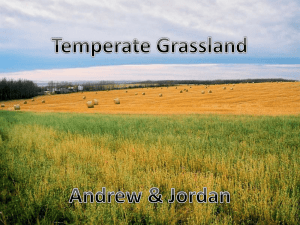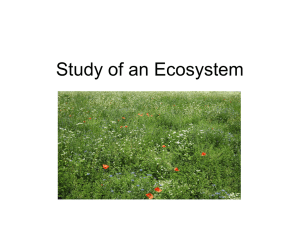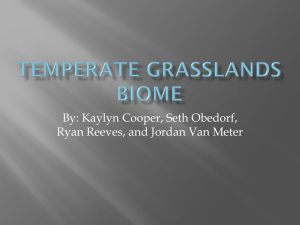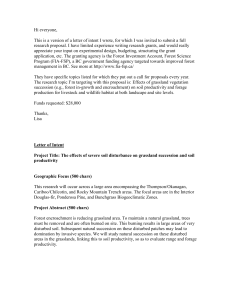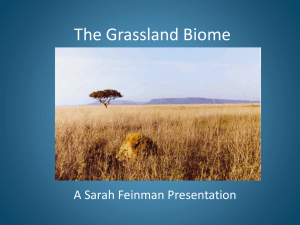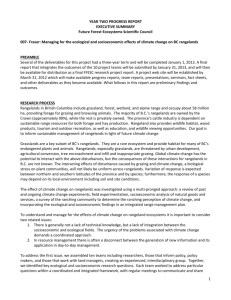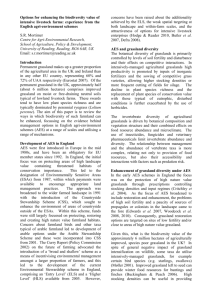Grassland Ecosystem: Abiotic Components Explained
advertisement
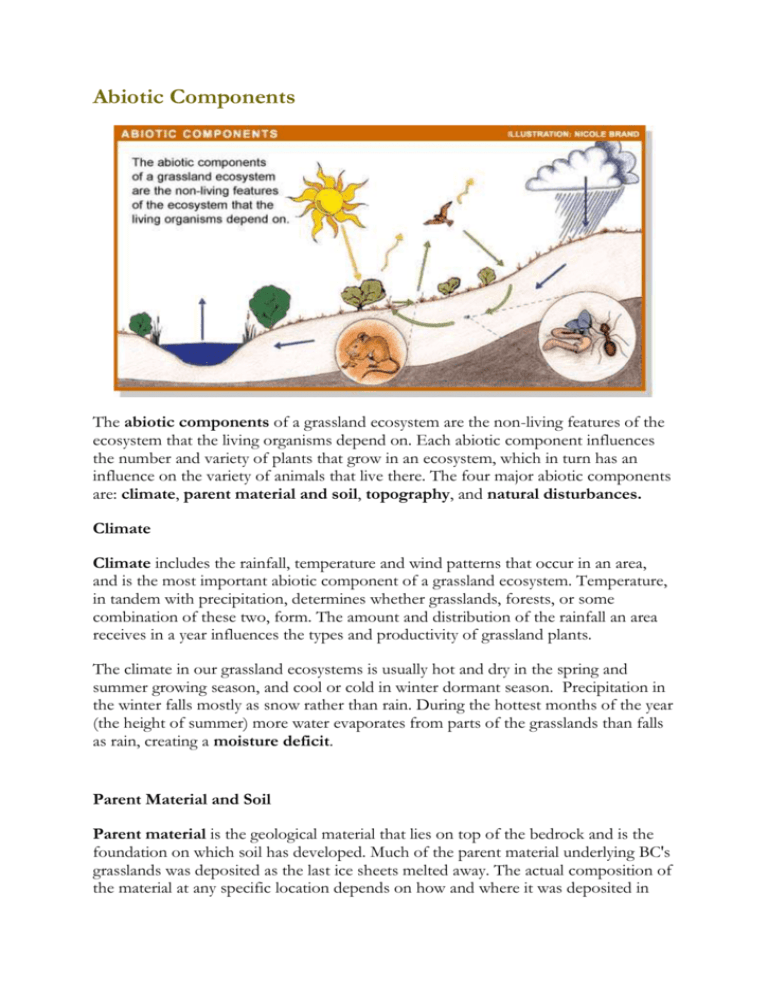
Abiotic Components The abiotic components of a grassland ecosystem are the non-living features of the ecosystem that the living organisms depend on. Each abiotic component influences the number and variety of plants that grow in an ecosystem, which in turn has an influence on the variety of animals that live there. The four major abiotic components are: climate, parent material and soil, topography, and natural disturbances. Climate Climate includes the rainfall, temperature and wind patterns that occur in an area, and is the most important abiotic component of a grassland ecosystem. Temperature, in tandem with precipitation, determines whether grasslands, forests, or some combination of these two, form. The amount and distribution of the rainfall an area receives in a year influences the types and productivity of grassland plants. The climate in our grassland ecosystems is usually hot and dry in the spring and summer growing season, and cool or cold in winter dormant season. Precipitation in the winter falls mostly as snow rather than rain. During the hottest months of the year (the height of summer) more water evaporates from parts of the grasslands than falls as rain, creating a moisture deficit. Parent Material and Soil Parent material is the geological material that lies on top of the bedrock and is the foundation on which soil has developed. Much of the parent material underlying BC's grasslands was deposited as the last ice sheets melted away. The actual composition of the material at any specific location depends on how and where it was deposited in relation to the ice. In the Rocky Mountain Trench, for example, some material was deposited under a moving glacier, while on the Chilcotin plateau some was deposited under a stationary ice sheet; in many places throughout the grasslands material was carried and deposited by water on, in, or under the ice. The material dropped in place under the ice varies in thickness from a thin veneer to several metres, and contains all sizes of rocks and particles from boulders to silts. Rivers and streams that flowed on, under and beyond the ice left hummocky ridges of water-rounded materials of all sizes. Material deposited in ice-damned lakes formed layers of fine silts. Winds picked up fine particles and blew them across the newly icefree land surface, depositing thick layers of the particles in some places. These windblown materials are called aeolian deposits. Soil develops in the upper portion of the parent material and is a mixture of abiotic and biotic components: minerals, organic matter, water and air. The type of parent material in a particular area influences the texture of the soil, how well water flows through it, and hence the chemistry and nutrients of the soil. This combination of texture, water flow and chemistry determines the vegetation that grows in the area. The fine silt soils found on the terraces of the Okanagan, Kootenay and Thompson valleys hold water near to the surface where it either evaporates or is soaked up by the dense fine roots of grasses; trees are not common in these areas. By contrast, in areas with gravelly soils water moves quickly down to depths below the grass roots to levels where tree roots grow. As such, more trees are likely to be found in these areas. Grasslands have a rich layer of organic matter that forms the top surface of the soil. This layer has developed largely as a result of the breakdown of plant roots. Roots form as much as half the volume of a grass plant and up to 50% are replaced every year. Soil Profile Grassland soils developed on the glacial till (C) deposited by the ice as it melted 12,000 to 10,000 years ago. These soils have a deep organic-rich layer (A) that results from the breakdown of the roots and plant material each year. The organic layer increases in depth with increases in elevation and moisture. Topography Topography is the variety of shapes found on the landscape determined by slopes, elevation and aspects. The topography of grassland ecosystems is a varied landscape of gently rolling hills and prairies, rock outcrops, cliffs, gullies, and low lying areas. Diverse topography is what gives incredible variety to grassland ecosystems. Aspect refers to the direction in which a piece of land is facing. Areas that face towards the south, or the sun, are hotter and drier than areas that face north, or away from the sun. The slope of an area is the angle at which the land lies. Slope is important in our grasslands as water may run downhill rather than soak into the ground where it is available for plants. An area that slopes with a southern aspect will be much drier and hotter than an area that slopes with a northern aspect. Elevation describes the height of land above sea level. Temperatures are generally cooler and rainfall is higher as elevation is gained. Natural Distrubance Natural Disturbances change grasslands in many ways, adding to the diversity of these ecosystems. Some types of disturbance, such as annual flooding of riparian areas along rivers and streams, can be predicted while others, such as a fire after a lightning storm, happen unexpectedly. Flooding occurs every spring in the riparian areas along the large rivers and lakes in the grassland areas of the province. The water comes from melting snow in the surrounding hills and mountains. The amount of water that flows down from the mountains and hills may rise very suddenly if: the snow is deeper than normal high temperatures cause the snow to melt very fast there are heavy rainfalls on the snow The flooding waters can alter stream and river banks and move soil, broken trees and shrubs downstream. Lightning storms are a common sight on a dry summer evening in the grassland areas of the interior of BC. Trees struck by lightning can explode into flames, spreading fire to the trees around them and onto the surrounding grasslands. Small trees are usually killed, but shrubs, grasses and other plants are able to survive. Most grassland grasses are in a dormant state before the heat of the summer when most lightning fires start. Grasses such as bluebunch wheatgrass, fescues, and needlegrasses start to regrow from the base and from underground parts as soil moisture increases in the fall. Many forbs, such as sagebrush mariposa lily, have underground bulbs that will sprout again the following spring. Shrubs may grow new shoots from unburned stems or underground parts. Mobile animals, such as California Bighorn Sheep, and animals in the soil usually survive, but those unable to flee or find cover may be killed. The seeds of some plants actually need fire to grow. The thick bark of big ponderosa pine trees protects it from fire in two ways: by insulating the living part of the tree from the heat of the fire and by popping off pieces of bark as they catch on fire. Fires are important for returning nutrients to the soil. Since grassland plants burn readily, fire spreads very quickly, and is thought to have been an important factor in maintaining the grasslands ecosystem.



